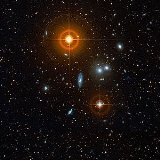
Hydra Cluster
Encyclopedia
The Hydra Cluster is a cluster of galaxies
that contains 157 bright galaxies
and can be viewed from earth in the constellation Hydra
. The cluster spans about ten million light years and has an unusual high proportion of dark matter
. The cluster is part of the Hydra-Centaurus Supercluster
located 158 million light years from earth. The cluster's largest galaxies are elliptical galaxies
NGC 3309 and NGC 3311 and the spiral galaxy
NGC 3312 all having a diameter of about 150,000 light years.
In spite of a nearly circular appearance on the sky, there is evidence in the galaxy velocities for a clumpy, three-dimensional distribution.
Galaxy groups and clusters
Galaxy groups and clusters are the largest known gravitationally bound objects to have arisen thus far in the process of cosmic structure formation. They form the densest part of the large scale structure of the universe...
that contains 157 bright galaxies
Galaxy
A galaxy is a massive, gravitationally bound system that consists of stars and stellar remnants, an interstellar medium of gas and dust, and an important but poorly understood component tentatively dubbed dark matter. The word galaxy is derived from the Greek galaxias , literally "milky", a...
and can be viewed from earth in the constellation Hydra
Hydra (constellation)
Hydra is the largest of the 88 modern constellations, measuring 1303 square degrees. It has a long history, having been included among the 48 constellations listed by the 2nd century astronomer Ptolemy. It is commonly represented as a water snake...
. The cluster spans about ten million light years and has an unusual high proportion of dark matter
Dark matter
In astronomy and cosmology, dark matter is matter that neither emits nor scatters light or other electromagnetic radiation, and so cannot be directly detected via optical or radio astronomy...
. The cluster is part of the Hydra-Centaurus Supercluster
Hydra-Centaurus Supercluster
The Hydra-Centaurus Supercluster , or the Hydra and Centaurus superclusters, is a supercluster in two parts and the closest neighbour of Milky Way's Virgo Supercluster....
located 158 million light years from earth. The cluster's largest galaxies are elliptical galaxies
Elliptical galaxy
An elliptical galaxy is a galaxy having an approximately ellipsoidal shape and a smooth, nearly featureless brightness profile. They range in shape from nearly spherical to highly flat and in size from hundreds of millions to over one trillion stars...
NGC 3309 and NGC 3311 and the spiral galaxy
Spiral galaxy
A spiral galaxy is a certain kind of galaxy originally described by Edwin Hubble in his 1936 work The Realm of the Nebulae and, as such, forms part of the Hubble sequence. Spiral galaxies consist of a flat, rotating disk containing stars, gas and dust, and a central concentration of stars known as...
NGC 3312 all having a diameter of about 150,000 light years.
In spite of a nearly circular appearance on the sky, there is evidence in the galaxy velocities for a clumpy, three-dimensional distribution.

